A review of "The Dark Knight" in IMAX
|
Read more
at in70mm.com The 70mm Newsletter |
| Written by: Ramon Lamarca Marques. Graphics and their captions by Brian Guckian | Date: 01.11.2008 + 04.06.2011 |
2011 (June 2) UPDATE |
|
|
The issue of dark presentations in 3-D and
also technical problems associated with 2-D presentations because of poor
projector setup have recently appeared on articles and forums on the
internet. This demonstrates that many customers do appreciate showmanship in
presentation. What we suggested in the past for "The Dark Knight" release still applies to the new Batman film, which will again contain IMAX (15/70mm) sequences. This would be a good opportunity for producing 5/70mm prints for those markets that do not have 15/70 IMAX theatres and thus providing something extraordinary and maximising the investment in high quality film acquisition when the film is released. We reproduce our previous article below. High resolution film presentation in 70mm is another tool that film producers and exhibitors can use in certain markets alongside 3-D to increase their revenue whilst offering varied experiences to their patrons and something that cannot be experienced at home. |
More
in 70mm reading: A Review of "The Master" in 70mm 65/70mm Workshop Internet link: |
|
******************** |
|
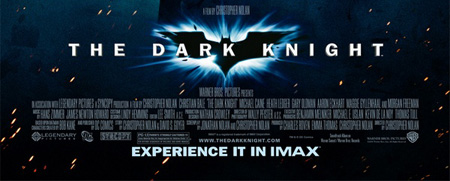 I did finally manage to see "The Dark Knight" on the IMAX screen last
Friday at the London BFI Imax. I was not going to see it any other way
and all in70mm.com readers will guess the reason why, the film contains
several sequences shot using IMAX proprietary system in 15/70 mm, which
holds the crown in image quality these days and hasn’t got any
competitor who even approaches its quality. This is the first commercial
film, which contains sequences shot with IMAX cameras. Curiously (and I
would add suspiciously), there has been little emphasis to the IMAX
scenes in the marketing of the film in London and yet the spectacular
nature of those scenes has made the film a huge success here. The word
of mouth has worked and audiences have realised that this was the best
way to see this film. This has created an unprecedented success for the
BFI London IMAX with extra screenings added and the film still going
strong after nearly three months of its release. The screening on Friday
was almost fully booked with very few empty seats and it looks like the
film will finish its running at the BFI Imax on full auditoriums. I did finally manage to see "The Dark Knight" on the IMAX screen last
Friday at the London BFI Imax. I was not going to see it any other way
and all in70mm.com readers will guess the reason why, the film contains
several sequences shot using IMAX proprietary system in 15/70 mm, which
holds the crown in image quality these days and hasn’t got any
competitor who even approaches its quality. This is the first commercial
film, which contains sequences shot with IMAX cameras. Curiously (and I
would add suspiciously), there has been little emphasis to the IMAX
scenes in the marketing of the film in London and yet the spectacular
nature of those scenes has made the film a huge success here. The word
of mouth has worked and audiences have realised that this was the best
way to see this film. This has created an unprecedented success for the
BFI London IMAX with extra screenings added and the film still going
strong after nearly three months of its release. The screening on Friday
was almost fully booked with very few empty seats and it looks like the
film will finish its running at the BFI Imax on full auditoriums.The IMAX scenes are truly impressive and immersive, making a wise use of the vertical landscape of the skyscrapers in Gotham city. The car chases reminded me of Cinerama immersive features, I was in the action; especially impressive is when the big truck flies over and lands on the pavement, stunning! It was also impressive seeing Batman standing on the top of one of those skyscrapers surrounded by the vastness of the city. |
|
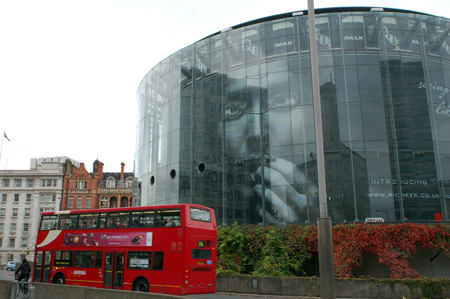 The BFI IMAX in London. Image by Thomas Hauerslev The BFI IMAX in London. Image by Thomas HauerslevThe non-Imax scenes are obviously not that impressive. Actually, the quality of the DMR Imax digital blowing-up process varied. Medium shots and close-ups work fairly well on the blow-up from 35mm but the long shots show the inferior quality of 35mm, they are stretched too much for the IMAX screen. They do not work. The change of ratio between IMAX and 35mm scenes is not as intrusive as I thought it would be, mainly because of the great number of dark settings the film has, although I would have obviously preferred the same ratio for the whole film. And so what does IMAX have that can produce such an unparalleled experience? The standard IMAX screen is 22 metres (72 ft) wide and 16.1 metres (53 ft) high, and it can be larger. Size does indeed matter. 3-D will probably arrive to home cinemas fairly soon, but a screen this size will NEVER be in any home-cinema setting and I emphasize the NEVER. And so to truly experience the impact of the IMAX scenes on "The Dark Knight" the only option is to pay the ticket admission and go to the theatre since at home, or on a 35mm print or a 2k digital video file that cannot be reproduced at all. And so when all studios are wondering about the future of cinema exhibition, they have one clear answer in front of their noses and what are they doing? What are they waiting to explore this possibility? Aren’t the IMAX screenings of The Dark Knight proof enough of the success of the system? I think the use of IMAX scenes has got future on the right film. Of course the framing of the scenes has to be vertical rather than horizontal and I actually found that some of the blow-up 35mm scenes were not so comfortable to see because they were wide rather than tall and this does not suit the IMAX screens. |
|
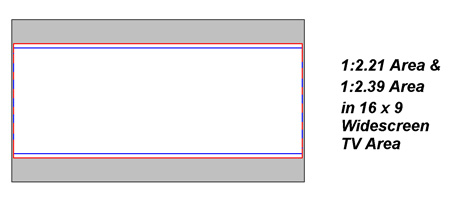 Comparison
between 1:2.21 and 1:2.39 aspect ratios as viewed on a 16 x 9 aspect ratio
television / display. Note that the difference in areas appears smaller than
actual due to both areas sharing a common horizontal centreline. Comparison
between 1:2.21 and 1:2.39 aspect ratios as viewed on a 16 x 9 aspect ratio
television / display. Note that the difference in areas appears smaller than
actual due to both areas sharing a common horizontal centreline.One wonders why they are not producing more films with IMAX proprietary cameras? Well, it is expensive and the cameras are bulky. Yet, Christopher Nolan and his director of photography have been able to show how they can be adapted very well to film action sequences with astonishing results. However, I think they should stop using 35mm for the non-IMAX scenes. If it is too expensive and too impractical to use IMAX cameras for the whole film, they should use conventional 65mm cameras for the close-ups and middle shots. Frankly, I think that if they used those cameras, since there wouldn’t be the need for such a big digital blow-up, the quality of the non-IMAX images would still be good and there wouldn’t be such a jump in quality from the IMAX and non-IMAX scenes. Actually, it may be a good idea to have a conventional 65mm camera adapted to allow for extra perforations so the ratio of the IMAX screen can be replicated, albeit at a smaller size, so when the non-IMAX scenes are blown-up there is less magnification needed and the whole screen can be filled up. Obviously, it is not financially feasible to have an IMAX screen in every village or city, those screens fare well in big cities and so the question is what happens to places where they do not have enough patrons to justify an IMAX screen. Well, the answer lies with the old 5/70 film format, which is compatible with conventional cinemas and produces a much, much improved image than those produced by 35mm prints and the unsatisfactory 2k resolution of digital cinema. Moreover, the 5/70 mm aspect ratio of 2.21:1 is more compatible to the IMAX aspect ratio than anamorphic widescreen’s ratio of 2.39:1, and so the compromising between aspect ratios would not be so obvious. |
|
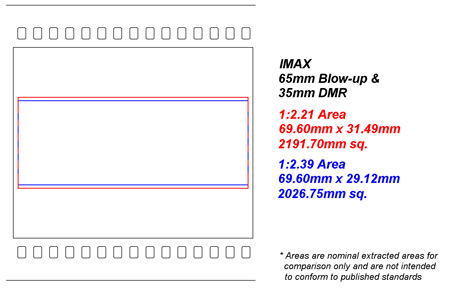 Nominal
frame area comparison between 65mm and 35mm material blown up to IMAX.
Again, the difference in areas appears smaller than actual due to both areas
sharing a common horizontal centreline. Nominal
frame area comparison between 65mm and 35mm material blown up to IMAX.
Again, the difference in areas appears smaller than actual due to both areas
sharing a common horizontal centreline.I am not in favour of different framings of the same film and I love really wide screen processes and I wish Ultra Panavision could make a come back, but at present, the compromise between IMAX vertical framing and 5/70 mm 2.21:1 aspect ratio seems a feasible option and one that with the right film could help cinema exhibition. Also, the extra top and bottom information that suits IMAX screens contains non-essential information and is not suited for conventional cinemas. Both IMAX 15/70 mm prints and conventional cinemas 5/70 mm prints when used on huge screens surpass enormously any home cinema resolution, which is clearly dwarfed in size and resolution by the two mentioned formats. I insist, huge screens, with films properly composed for them with a high resolution negative and a high resolution print is something that cannot and will not be experienced at home, ever, and this is what all the audiences going to the London Imax were after. |
|
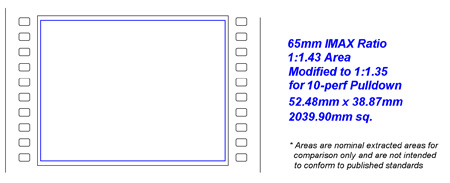 Suggested
10-perf pulldown modification to the conventional 5-perf 65mm shooting
format to yield a 65mm negative area of comparable aspect ratio to 15/70
IMAX. Of course, conventional 8-perf could also be used, albeit with a
slightly reduced image size to maintain the IMAX aspect ratio. Suggested
10-perf pulldown modification to the conventional 5-perf 65mm shooting
format to yield a 65mm negative area of comparable aspect ratio to 15/70
IMAX. Of course, conventional 8-perf could also be used, albeit with a
slightly reduced image size to maintain the IMAX aspect ratio.It has been mentioned by other people before and I think the same, IMAX must be careful with the use of its brand. IMAX equals big screen with 15/70 filming and projection systems, anything else is just not IMAX. They should take example from history. Cinerama started cheapening their brilliant three projector system and they ended blowing up 35mm and selling it as presented in Cinerama, they did that with "The Ten Commandments" in Barcelona, re-released and advertised as presented in Cinerama. The same happened with 70mm, which was a brand linked with high quality 65mm and then later on was used also to promote films in cropped 35mm photography blown-up to 70mm. The tactic is well-known: a company produces a good quality product, when the customer is used to the good quality of the brand, the company degrades its quality and still sells the product with the same brand, for the same price, pretending it is the same, but it isn’t. In the end the customer gets fed-up and cheated and abandons the brand. It is a short-term solution for the company but it never works long term. And so, the idea that Christopher Nolan has started could work with the right films, it won’t save a turkey of course. It is important that audiences are not deceived. For instance, "Eagle Eye", which is having an IMAX release, will never be the same experience, because none of its scenes have been shot using IMAX proprietary high-resolution film cameras. By confusing audiences with misleading marketing, the chances of survival of Christopher Nolan’s idea are lessened. Action films with a mixture of IMAX cameras scenes and conventional 65mm cameras scenes blown-up, could be a good idea for both IMAX theatres and conventional theatres with 70mm projection systems. It should be marketed clearly that the best enjoyment comes from the IMAX presentation (real IMAX, not the digital IMAX) followed by the 5/70 presentation at conventional cinemas. As stated, this won’t suit every single film, but I do not think there is a universal solution for all films, some of them will be suited for 3-D, some of them for really wide screens, … It is a good idea not to put all the eggs in the same basket! |
|
|
Go: back
- top - back issues
- news index Updated 22-01-25 |
|
